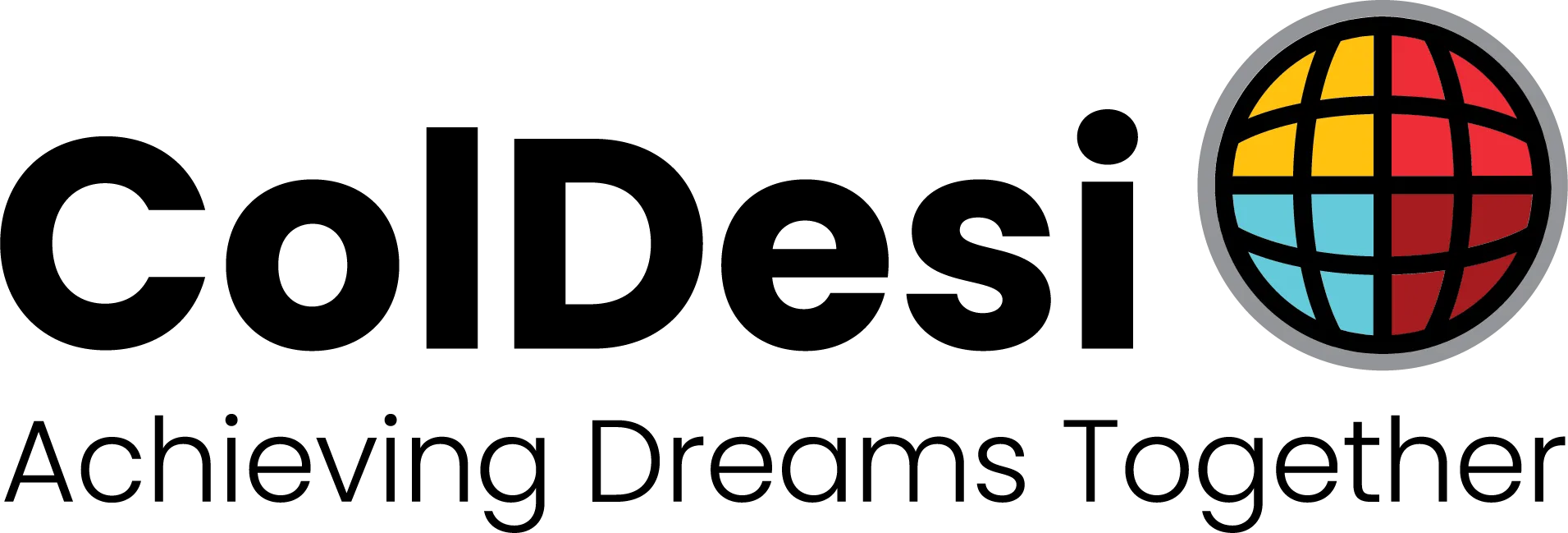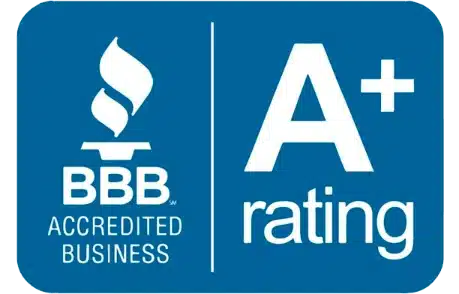Ad copy – Lettering imprinted on an item. Can be an advertiser’s name, slogan, or trademark. 
Appliqué – The use of fabrics sewn onto one another for decoration that adds dimension and texture. Reduces the amount of embroidery stitches needed to fill the design area.
Arm machine – Multi-head embroidery machine driven by a single main shaft. Each sewing head is attached to the shaft, usually by gears. Sewing heads resemble industrial sewing machines in the “arm” that the needle case is attached to.
Automatic color change – The ability of a multi-needle commercial embroidery machine to follow a command to change to another specified needle without intervention.
 Backing – A woven or non-woven support material added to the back of the fabric being embroidered. Backing can be hooped with the item or placed between the machine throat plate and the hooped item. It comes in various weights in three types tearaway, cut-away, and wash-away.
Backing – A woven or non-woven support material added to the back of the fabric being embroidered. Backing can be hooped with the item or placed between the machine throat plate and the hooped item. It comes in various weights in three types tearaway, cut-away, and wash-away.
Bean stitch – Three stitches placed back and forth between two points. Often used for outlining because it eliminates the need for repeatedly digitizing a single-ply running stitch outline.
Birdnesting – Collection of thread between goods and needle plate that resembles a bird’s nest. Its formation prevents free movement of goods and may be caused by inadequate tensioning of the top thread or flagging goods.
Blatt stitch - Schiffli term meaning “to feed the yarn”, which produces a long zig zag stitch with threads lying close together.
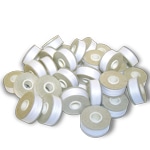 Bobbin - A spool that is inside of the hook. The bobbin thread forms the stitches on the underside of the garment. The bobbin on an embroidery machine works the same way as on a home sewing machine.
Bobbin - A spool that is inside of the hook. The bobbin thread forms the stitches on the underside of the garment. The bobbin on an embroidery machine works the same way as on a home sewing machine.
Bobbin case – Small, round metal device for holding the bobbin. Used to tension the bobbin thread, it is inserted in the hook for sewing.
Boring – Openwork incorporated into embroidered designs; a sharp pointed instrument punctures the fabric, and stitches are made around the opening to enclose the raw edges.
Bridge machine - A bridge machine has the heads suspended on a bridge that goes across the machine. Without the arm on the base, a bridge machine is able to provide a larger sewing field from front to back on the machine. A bridge machine is good for cut pieces and also for yard goods. Compare with arm machine.
Buckram – A woven fabric treated with a glue substance to stabilize fabric for stitching. It is commonly used for caps to hold the front panel in place.
Cap frames - Specialized embroidery frames designed to hold finished caps for embroidering. Available in a variety of styles for various machines, with two basic styles being to sew the finished cap flattened out, or sewing the finished cap (on a tubular machine) in its natural curve.
Cartoon - Finished artwork of an embroidery design to be digitized.
Chain stitch - Stitch that resembles a chain link, formed with one thread fed from the bottom side of the fabric. Done on a manual or computerized machine with a hook that functions like a needle.
Check spring - Assists in upper thread tensioning and is used to detect upper thread breaks in many embroidery machine models.
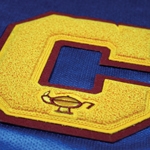 Chenille - Form of embroidery in which a loop (moss) stitch is formed on the top side of the fabric. Uses heavy yarns of wool, cotton, or acrylic. Created by a chain stitch machine that has been adjusted to form this stitch type.
Chenille - Form of embroidery in which a loop (moss) stitch is formed on the top side of the fabric. Uses heavy yarns of wool, cotton, or acrylic. Created by a chain stitch machine that has been adjusted to form this stitch type.
Colorfill - Combination of the Deboss and color, deboss then filled.
Column stitch - A series of zigzag stitches placed closely together to form a column. Also know as a steil stitch or satin stitch.
Complex fill - Refers to a digitizing capability that allows areas to be designated as voids at the same time the design’s edges are defined. The design can thus be digitized as one fill area, instead of being broken down into multiple sections.
Condensed format - Method of digitizing in which a design is saved in a skeletal form. A proportionate number of stitches may later be placed between defined points after a scale has been designated. With a machine that can read condensed format, the scale, density and stitch lengths in a design may be changed.
Conversion software - Programs that read information and translate it from one machine to another.
Customizing - (see editing)
Cylinder arm machine - Refers to machines with “cylinder” beds. The hook assembly is housed in a cylinder shaped arm, allowing goods to curve around the cylinder for embroidery.
Deboss - Machine presses a die into the surface of the material, resulting in a depressed imprint.
Design library / catalogue – A computer program which catalogs a collection to digitized designs kept by embroidery shops for embroiderers to access the design by subject, stitch count, etc.
Digitizing - A modern term for punching, it is a method of programming a design. Artwork is converted into a series of commands to be read by an embroidery machine’s computer.
Digitizing tablet - A computer aided design device used by digitizers to plot needle penetrations for embroidery designs. Typically, a pencil drawing of the design is enlarged and then taped to this tablet. The digitizer then uses a device known as a puck to indicate stitch types, shapes, underlay, and actual needle penetrations.
Disk reader - An external or internal device used to read machine movements from a computer disk.
Download - Transferring a file from the Internet to your computer.
Editing - Changing aspects of a design via a computerized editing program. Most programs allow the user to scale designs up or down, edit stitch by stitch or block by block, merge lettering with the design, move aspects of the design around, and other features.
Emblem - Embroidered design with a finished edge, commonly an insignia of identification.
Embroidery point - Unit of measurement in embroidery, in which 10 points equals 1 mm.
Embroidery unit - The machine part that holds and guides the hoop so you can embroider.
Expanded format - A format in which all the stitches are in place and the design is specified to be a specific size. Designs digitized in expanded format are not designed to be changed in size.
Fill stitch - Series of running stitches commonly used to cover large areas. Different fill patterns can be created by altering the angle, length and repeat sequence of the stitches. Also known as a geflect stitch.
Finishing – Processes performed after embroidery is complete. Includes trimming loose threads, cutting or tearing away excess backing, removing topping, cleaning any stains, pressing or steaming to remove wrinkles or hoop marks and packaging for sale or shipment.
Flagging - Up and down motion of goods under an embroidery head for the application of embroidery.
Flat embroidery - Embroidery that is framed in hoops, usually exclusively on the top of the embroidery machine’s hook assembly.
Font - Used to describe a complete typeset from a particular typeface. Examples include Helvetica, Times New Roman, Arial, Verdana, etc.
Format - Machine specific readable information.
Frame - Holding device for insertion of goods under an embroidery head for the application of embroidery.
Framing press - Machine to aid the framing process.
Frame sash - Part of the pantograph to hold the frames. Also called a sash.
Geflect stitch - See Fill Stitch.
GIF - Graphic Imaging Format; a type of picture file.
Hardware - The physical parts of a computer.
Hook - Holds the bobbin case in the machine and plays a vital role in stitch formation. Making two complete rotations for each stitch, its point meets a loop of top thread at a precisely timed moment and distance to form a stitch.
Hook assembly - Rotary device designed to pass the needle at a given point in the needle bar rise. The hook point passes into a thread loop formed by the rising needle bar and pulls the thread around the bobbin case to form a lock stitch.
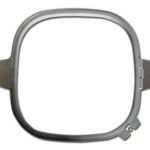 Hoop (noun) - A device made from wood, plastic, or steel with which fabric is held in place for machine embroidering. A frame that attaches to the embroidery unit to hold the fabric taut while stitching.
Hoop (noun) - A device made from wood, plastic, or steel with which fabric is held in place for machine embroidering. A frame that attaches to the embroidery unit to hold the fabric taut while stitching.
Hoop (verb) - The process of placing the fabric and/or stabilizer into the embroidery hoop. Hooping board - Board designed to hold the outer portion of the hoop while the goods to be embroidered are placed over the board to be hooped. One the goods are aligned and placed correctly over the outer hoop, the operator inserts the inner portion of the hoop.
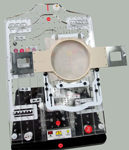 Hooping device – Device that aids in hooping garments or items for embroidery. Especially helpful for hooping multilayered items and for uniformly hooping multiple items.
Hooping device – Device that aids in hooping garments or items for embroidery. Especially helpful for hooping multilayered items and for uniformly hooping multiple items.
Italic – In type, letter forms that slope to the right. Example: italics Jumbo rotary hook – Rotary hook which holds a bobbin case with a much larger thread capacity than a standard hook.
Jump stitch - Movement of the frame without stitching but with takeup lever and hook movement.
Kern - To add or delete space between pairs of adjacent characters.
Lettering - Refers to the embroidery of letters, either made completely with stitches, or a combination of cutout appliqué pieces and stitching.
Lock stitch - Commonly referred to as a lockdown or tackdown stitch, a lock stitch is formed by three or four consecutive stitches of at least a 10point movement. It should be used at the end of all columns, fills, and at the end of any element in your design where jump stitches will follow, such as color changes or the end of a design.
Lock stitch machine - Machine which forms a stitch using a hook and needle. Includes home sewing machines, as well as computerized embroidery machines.
Logo - Name, symbol or trademark of a company or organization.
Looping - Loops on the embroidery surface generally caused by poor top tension or tension problems. Typically occurs when polyester top thread has been improperly tensioned.
Machine language - The codes and formats used by different machine manufacturers within the embroidery industry.
Marking - Marking of goods to serve as an aid in positioning the frame and referencing the needle start points.
Modular - Machine system where many separate stitching heads or head configurations are controlled by a central computer.
Monogram - Embroidered design composed of one or more letters, usually the initials in a name.
Moss stitch - See chenille.
Nap - A fuzzy or downy surface of fabric covering either one side or both, produced by brushing embroidery machine needlesNeedle Small, slender piece of steel with a hole for thread and a point for stitching fabric. A machine needle differs from a handwork needle; the machine needle’s eye is found at its pointed end.
Needle plate - The metal plate located above the hook assembly of an embroidery machine. This plate has a hole in the center through which the needle travels to reach the hook and form a stitch.
Network - To link embroidery machines via a central computer and disk drive system. A group of machines linked via a central computer.
Nippers - See Thread Clippers.
Offset – The ability to move the pantograph out of the design with a specific movement and then return to the original point. Used for placing appliqué.
Origin - The starting point of your design.
Overrun - Specialties produced in excess of the number originally ordered.
Pantograph - A bar, rack, or holder that frames or holding fixtures are attached to. The pantograph moves in X and Y directions to form the embroidery design, controlled electronically or mechanically depending on the machine.
Pencil rub - A low cost way of producing a “sample” of an embroidery design. Consists literally of a piece of tracing paper placed over a sew out and rubbed lightly with a pencil to produce an impression of the embroidery.
Presser foot - Metal device that touches the goods being embroidered while the needle is in the goods. The main function of the presser foot is to hold the material being embroidered until the hook point catches the thread loop formed by the needle rise.
Pretensioner - Thread tension assemblies that are before the main tension assembly in the thread path. The function of the pretensioner is to apply a light amount of tension in order to make the main tensioner work.
Puckering – Result of the fabric being gathered by the stitches. Many possible causes include incorrect density, loose hooping, lack of backing, incorrect tension, or dull needle.
Pull compensation - A degree of distortion built into a design by the digitizer to compensate for pull on the fabric caused by the embroidery stitches.
Registration - This refers to the ability to line up details and parts of designs with each other.
Repeat - Layout used for making emblems or designs on a fabric span that are repeated at regular intervals.
Running stitch - One stitch which goes Point A to Point B. A running stitch is often used for fine details, outlining, and underlay. Consists of one stitch between two points. Used for outlining and fine detail. Also known as a walk stitch.
Sans serif – A type style without cross strokes at the end of the main strokes. Example: Arial is a sans serif font.
Serif - Any typeface with letters having cross strokes at the end of the main strokes. Example: Times New Roman is a serif font.
Satin stitch - A series of zigzag stitches which are formed closely together. A satin stitch is normally anywhere from 2 mm to 12 mm.
Scaling - Ability within one design program to enlarge or reduce a design. In expanded format, most scaling is limited to 10 percent to 20 percent because the stitch count remains constant despite final design size.
Scanner - A device that takes a computer readable picture of artwork and brings it into the computer memory so you can digitize the design with your software.
Short stitch - A digitizing technique that places shorter stitches in curves and corners to avoid an unnecessary bulky buildup of stitches.
Software - Programs and/or files that the hardware uses to learn or perform different tasks. In embroidery this is normally digitizing software.
Specialty fill - A fill stitch capability that produces a fill with a relief or motif design within the fill stitch area.
SPI - Stitches per inch.
SPM - Stitches per minute.
Steil stitch - See Column Stitch.
Stitch editing – Digitizing feature that allows one or more stitches in a pattern to be deleted or altered.
Stitch processing - The calculation of stitch information by means of specialized software, allowing scaling of expanded format designs with density compensation.
Stock Designs - Digitized embroidery designs that are commercially available for general use by embroiderers.
Swiss embroidery - Satin stitch embroidery.
Tackle twill – Letters or numbers cut from polyester or rayon twill fabric that are commonly used for athletic teams and organizations.
Take up spring - See Check Spring.
Tension – Tautness of thread when forming stitches. Top thread tension, as well as bobbin thread tension, needs to be set. Proper thread tension is achieved when about one third of the thread showing on the underside of the fabric on a column stitch is bobbin thread.
Tensioner - Device used to adjust the tautness of thread when forming stitches.
Thread - Fine cord of natural or synthetic material made from two or more filaments twisted together and used for stitching. Machine embroidery threads come in rayon, which has a high sheen; cotton, which has a duller finish than rayon but is available in very fine deniers; polyester, which is strong and colorfast; metallics, which have a high luster and are composed of a synthetic core wrapped in metal foil; and acrylic, which has rayon’s sheen.
Thread clippers - Small cutting utensil with a spring action that is operated by the thumb in a hole on the top blade and the fingers cupped around the bottom blade. Useful for quick thread cutting, but unsuitable for detailed trimming or removal of backing.
TIFF (or TIF) - Tagged Image File Format, it is a type of graphics file.
Topping - Material hooped or placed on top of fabrics that have definable nap or surface texture, such as corduroy and terry cloth, prior to embroidery.
Trimming - The action of cutting loose thread, removing backing, etc., from the final embroidered product.
Tubular embroidery - Embroidery produced on an embroidery machine which allows tubular fabric or preassembled garments to be placed around the hook assembly. Allows sewing of the front of a garment without sewing through the front and back of it.
Two-ply stitch - A double running stitch. The stitch is formed by the machine sewing a complete running stitch area and then coming back over the same area and stopping where it started. Sews from Point A to Point B and then from Point B to Point A.
Underlay - Used under the regular stitching in a design. The stitches are placed to provide stability to the fabric and to create different effects. Underlay is normally a series of running stitches or a very light density fill often placed in the opposite direction that the stitching will go.
Underlay stitch - Stitches laid down before other design elements to help stabilize stretchy fabrics and to tack down high wales or naps on fabrics so the design’s details don’t get lost.
Variable sizing - Ability to scale a design to different sizes.
Verify - Sample sew out or printout of a new embroidery design to make sure the pattern is correct.
Walk stitch - See Running Stitch
